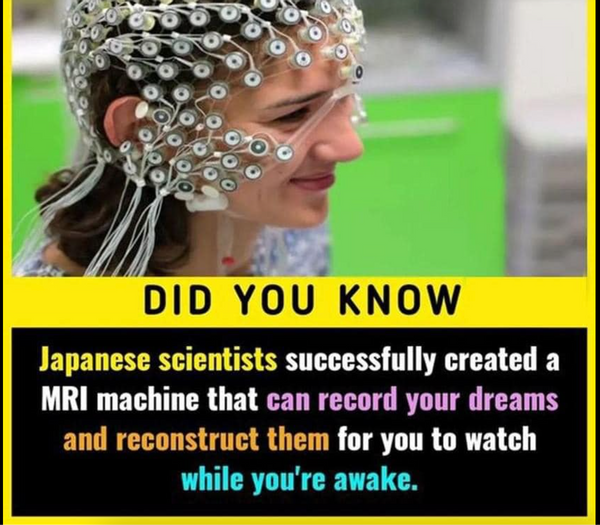In 2013, Japanese researchers published a study describing a method for "recording dreams" by using functional magnetic resonance imaging (fMRI) to record brain activity associated with particular objects when a subject is both awake and asleep. The resulting recordings consist of flashes of images of objects that correlate with this brain activity.
The result is not a direct-to-video recording in the usual sense, nor does it comprise a narrative record of a subject's dream as some social media posts have suggested. Rather, the clips consist of a rapid succession of still images assembled with the help of a machine learning program.
The development of a technology to record and replay dreams like a movie, allowing dreamers to relive their wildest sleeping fantasies and nightmares alike, seems like the stuff of science fiction. But in 2013, news of an experiment that at least partially validated the idea made headlines in media publications including The Verge, NPR, and BBC.
The news resurfaced again over a decade later, albeit in somewhat exaggerated form, when a meme shared to Facebook on Jan. 15, 2024, claimed the following:
 (Screengrab/Facebook)
(Screengrab/Facebook)
It is true that in 2013, Japanese research developed a technology to “read” and "record" dreams, so to speak, but said recordings weren't “like a movie,” as some social media posts claimed. As such, we have rated this claim as Mixture.
Publishing their work in the peer-reviewed journal Science, the Japanese researchers described a method of recording dreams by using functional magnetic resonance imaging (fMRI), a noninvasive technique that the University of California, San Diego, described as being used for measuring and mapping brain activity.
This “neural decoding approach” utilized machine-learning models that would match particular brain activity patterns to particular objects, both when a test subject was awake and asleep.
Dreaming is often, though not always, associated with visual experiences. But do our brains behave in the same way when we see something while awake as they do when we’re asleep? To find out, the researchers recorded the brain activity of three test subjects – a relatively small sample size – when the subjects were shown a variety of objects when awake.
In addition to the fMRI, scientists equipped these test subjects with an electroencephalogram (EEG), a test the Mayo Clinic described as a method to measure electrical activity in the brain using small, metal discs (electrodes) attached to the head. Participants were then asked to fall asleep and were awakened as soon as the EEG detected brain activity that indicated they were dreaming.
Upon awakening, scientists asked the subjects to describe the contents of their dream, and, as the fMRI also recorded brain activity during the dream, the scientists attempted to match objects visualized in the dream to those seen by the subjects while awake based on corresponding brain activity patterns. The process was repeated until researchers had obtained 200 visual reports from each subject.
Words describing visual objects were grouped into 20 basic categories, such as male or female, and each verbal report was then represented by an image.
This data was then input into a decoder, which was described by the scientists in an April 5, 2013, Science Podcast interview as a machine learning model that predicted visual content given the measured brain activity by using an algorithm that could identify fine-scale, picture by picture images.
The result? Though brain activity associated with a given object differs from person to person, individuals experience the same brain activity associated with the object when they're awake as they do when they're dreaming. The resulting "recordings" consisted of flashes of objects that correlated with this brain activity, though not a movie-like narrative as some have suggested.
“Together, our findings provide evidence that specific contents of visual experience during sleep are represented by, and can be read out from, visual cortical activity patterns shared with stimulus representation,” concluded the researchers.
“Our method may further work beyond the bounds of sleep stages and reportable experience to uncover the dynamics of spontaneous brain activity in association with stimulus representation. We expect that it will lead to a better understanding of the functions of dreaming and spontaneous neural events.”
Snopes reached out to the study's authors to ascertain where the research stood as of January 2024. Study author Yukiyasu Kamitan, professor of the Graduate School of Informatics at Kyoto University, wrote that "there is not much progress specifically on dreaming."
However, the researchers have improved their visual image reconstruction methods that now allow for reconstructing arbitrary images that are not restricted to categories used for the study above.
"The [newly updated] model can reconstruct images that reflect subjective visual experiences, too, such as mental imagery, attention, and illusions. We are now testing sleep data to see if the generated images reflect dream content," Kamitan wrote.

